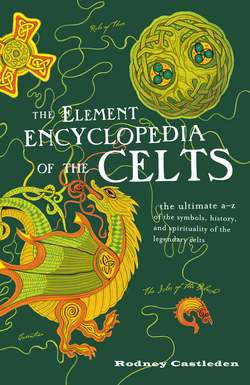Читать книгу The Element Encyclopedia of the Celts - Rodney Castleden - Страница 111
CUNOBELIN
ОглавлениеKing of the Catuvellauni tribe, son of Tasciovanus, and grandson or great-grandson of Cassivellaunus. He was the successor of Dubnovellaunus, King of the Trinovantes, the Catuvellauni’s eastern neighbors, when he died in about AD 10. Dubnovellaunus had fled to Rome, taking refuge at the court of Augustus when the Catuvellauni had annexed his territory and had no doubt been hoping that the emperor would intervene on his behalf. Cunobelin anticipated trouble from Rome and prudently became a Roman ally. As a client king he could expect favorable treatment from Augustus.
Cunobelin was a strong ruler and under his leadership the old imposed alliance between the Catuvellauni and the Trinovantes was re-asserted. This expanded kingdom was undoubtedly the strongest political entity in Britain on the eve of the invasion by the emperor Claudius in AD 43, and the Roman historian Suetonius described Cunobelin as “King of Britain.”
Cunobelin ruled the large joint kingdom from Camulodunum, near modern Colchester, which was previously the chief settlement of the Trinovantes. This move appears to have been made in order to tap into the European trading network more easily.
Camulodunum was a large urban complex covering 12 square miles (30 square km) and marked out by flanking rivers and big earth ramparts. It was a major industrial focus that included a mint. At Gosbecks there was a massive concentration of expensive imported pottery in one area, which was probably Cunobelin’s palace. Nearby there was a royal burial ground.
Cunobelin and his court were Romanized Celts. They were native Britons, but they were also keen to acquire all the luxury goods they could from Rome. They may have adopted Latin; some Latin graffiti have been found, though they could have been inscribed by Roman visitors. The Catuvellaunian aristocrats were in effect being bought or groomed by Rome in advance of the Claudian invasion. Having some client kings in Britain made invasion and annexation much easier.
Strabo observed that certain British kings “procured the friendship of Caesar Augustus by sending embassies and paying court to him.”
Cunobelin is the original of Shakespeare’s Cymbeline, and the only pre-Roman chief to be remembered in later times. Shakespeare’s portrayal of Cymbeline bears little relation to history, except for the idea that a client king was expected to pay annual tribute to Rome and that he found this hard to suffer:
…Britain is
A world by itself, and we will
nothing pay
For wearing our own noses.
The Lexden Tumulus in Colchester may be the grave of Addedomarus or of Cunobelin. It is about the right date to be Cunobelin’s, and of the right status. It contained chain-mail armor, Roman bronzes, furniture, and 15 wine amphorae. The bronze ornaments in the grave date from the eve of the invasion by Claudius. One of the grave goods is a pendant made out of a silver coin with a fine portrait bust of the young Augustus on it (see Places: Lexden Tumulus).
Cunobelin may have worn the pendant: he saw himself as the British Augustus. On his own coins he had the portrait of Augustus imitated and labelled CVNO.
After Cunobelinus’s death, his two sons, Togodumnus and Caratacus, expanded Catuvellaunian power even more aggressively than their father. They seemed to be fearless of the Romans hesitating to invade on the other side of the Channel.
